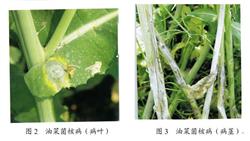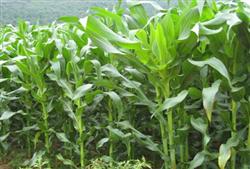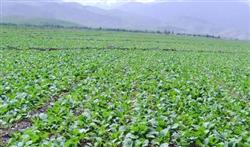Integrated control of Sclerotinia sclerotiorum in rape

Sclerotinia sclerotiorum is an important disease of rape, which is widely distributed in China, especially in the Yangtze River Basin and South China. It occurs 10% to 30% in general years, and 80% in serious cases. Sclerotinia sclerotiorum is caused by a fungus. It can occur at all stages of rape growth, but it is most serious after flowering. Seedling disease caused seedling rot, death or poor growth; adult stage leaves showed large and irregular leaf spots and deciduous, stem disease formed prismatic, long or large spots around the stem. In case of wet weather, the disease was wet rot, white cotton flocculent hyphae grow, called "white culm" or "mold culm." The fruit pods are also wet and rotten. The two important characteristics of Sclerotinia sclerotiorum are the production of white cotton flocculent hyphae from infected parts in wet environment and the formation of black sclerotia similar to rat dung in later stage (especially in the middle and lower parts of stems). The fungus overwinters in soil, seeds and diseased plants of winter rape as sclerotia. Sclerotia can survive for 4~10 years in dry condition, but it will rot in 30 days in water at 30℃. Overwintering sclerotia begin to form ascospores in February ~ March, and produce a large number of ascospores one after another. This period happens to be the flowering period of rape most susceptible to disease, and then encounter rainy weather, disease may be epidemic. For this reason, rotation, especially rice-drought rotation; no continuous cropping and no rotation with cruciferous vegetables such as cabbage and radish are the primary control measures. In addition, the parasitism of the pathogen itself is weak, and it can only infect old and yellow leaves, petals and anthers from wounds or natural orifices. According to the investigation, the petal carrier rate can be as high as 90%, and falling flowers have become a very important mode of infection. Therefore, it is necessary to comprehensively adopt agricultural measures to prevent diseases and spray pesticides to control diseases. Agricultural measures with disease prevention effect include: rational fertilization, balanced application of nitrogen, phosphorus and potassium fertilizers, increased application of boron, manganese and zinc micro-fertilizers, stable application of bolting fertilizer (only 20% of the total fertilizer amount), no use of undecomposed organic fertilizer; planting disease-resistant varieties, usually mustard type, relatively resistant to disease; ditching and drainage to reduce waterlogging and reasonable close planting to reduce field humidity; timely removal of old leaves, yellow leaves and diseased leaves, deep burial or composting to reduce germs. Chemical control can be used 40% Sclerotinia sclerotiorum WP 1000 times solution or 50% procymidone WP 50g per mu, or 50% iprodione WP 100g per mu mixed with water spray There are also reports of prochloraz (make 100 grams), chloropicrin, boscalid and other new agents and some compound agents such as 25% multi-drug. Ketone (gibberellin) WP, Fu? Sclerotinia sclerotiorum WP has good control effect and can be used alternately. It is suggested that the first spraying should be done at full flowering stage of rape, and the second spraying should be done at an interval of 7~10 days.
- Prev

Seven bases for High yield selection of Spring sowing Maize
When sowing, apply compound fertilizer 30ml / mu 40kg, fertilizer should be applied between two rows or two plants of corn, the depth is more than 10cm, cover the soil after application. At the 3-leaf stage, light dung water can be irrigated once, 1500Mu and 2000kg per mu. After fixing seedlings at the 5-leaf stage, look at the amount of base fertilizer and the growth of corn.
- Next

There are taboos about growing rape.
In traditional rape cultivation, it is necessary to raise seedlings in seedbed first, and then ploughing, border, transplanting and so on. There are many working procedures, many labor, high labor intensity and high cost, which restrict the expansion of rape planting area and the improvement of economic benefits. In recent years, a new rape cultivation technology is being demonstrated and gradually promoted in the field and locally.
Related
- The first cup of black tea in spring, the flavor and history of tea gardens in Kenya, Africa
- The computer can not only choose potatoes, but also grow tea rice. AI will grow winter oolong tea champion.
- It is not only the inflated tea bitten by insects, but also engraved with the four seasons tea in Beipu.
- The Oriental Beauty Tea Festival in Zhuxian County takes the stage at the weekend to experience the plus-size feast of oil tea.
- & quot; Oriental Beauty Tea & Exploration of Emei in Hsinchu, the hometown of quot;
- The new variety of strawberry "Tainong 1" dessert is the first choice with mellow aroma. Crimson gorgeous
- History of Tea in Taiwan: from Wild Inner Mountain to Export Tea Garden
- Two types of Taiwan Oriental Beauty Black Tea won the British three-Star Award for Childhood Tea Xiang Zhang Jiaqi changed from pilot to champion tea maker.
- Banana species and varieties: the planting history of Taiwan Xianren banana and dwarf banana is long, is banana disease resistant?
- Coffee planting Technology: Qianjie Coffee from Seedling to harvesting

